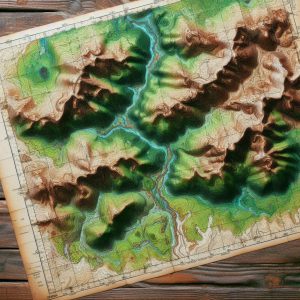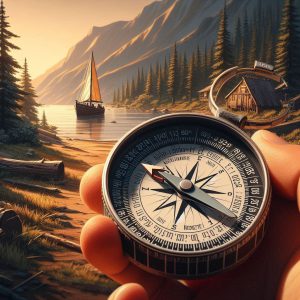Master Wilderness Navigation Skills Without GPS for Unforgettable Outdoor Adventures
Acquiring expert map and compass navigation skills can transform your outdoor experiences from daunting to exhilarating. Navigating the wilderness without the crutch of modern technology empowers you to connect with the natural world on a deeper level. At its essence, effective navigation depends on your ability to understand the landscape around you, allowing you to determine your position and chart a course to your intended destination. A well-crafted map acts as a vital two-dimensional guide, while a compass ensures you can orient yourself accurately using cardinal directions. Mastering these fundamental tools not only enhances your confidence but also enriches your adventures in the great outdoors.
Kickstart your journey into wilderness navigation by immersing yourself in the various symbols and scales featured on a map, as these elements are essential for effectively interpreting the physical landscape. Understanding contour lines that represent elevation changes is paramount, as this knowledge enables you to identify geographical features such as hills, valleys, and other significant landmarks that may impact your route. Additionally, honing your skills in compass usage is equally vital, as it equips you with the ability to navigate confidently through the wilderness, independent of GPS devices.
To orient your map accurately, simply hold your compass flat in your hand and rotate your map until the magnetic north aligns with the north indicated on the compass. This pivotal process, referred to as “orienting the map,” is crucial for maintaining precise navigation efforts. By grasping this technique, you ensure that your understanding of the terrain is accurate, significantly improving your chances of staying on course as you venture into the wild.
With your map properly oriented, you can now utilize the compass to take precise bearings that will serve as your guiding path. By effectively combining these two powerful navigational aids—the map and the compass—you’ll find yourself confidently traversing unfamiliar landscapes, ensuring that you remain on the right track even without the support of modern technological devices.
Essential Strategies for Successful Outdoor Navigation
- Mastering map and compass navigation is crucial for anyone engaging in wilderness exploration or outdoor activities.
- Topographic maps provide intricate insights into terrain features, elevation, and natural landmarks, which are essential for effective navigation.
- A compass not only establishes direction but also enhances navigation efficiency by aligning with the map’s orientation and understanding magnetic north.
- Utilizing natural landmarks and cues, such as distinctive rock formations or unique tree patterns, can serve as effective navigational aids when a map or compass is unavailable.
- Estimating distance and travel time is vital for planning and executing a successful navigation strategy in wilderness environments.
 Unlocking the Value of Topographic Maps for Wilderness Navigation Mastery
Unlocking the Value of Topographic Maps for Wilderness Navigation Mastery
Topographic maps are indispensable tools for anyone preparing to venture into the wilderness. These maps provide a comprehensive array of information about the terrain’s physical features, utilizing contour lines to depict elevation changes accurately. This visualization enables you to grasp the shape and steepness of the landscape, which is critical for anticipating the challenges you may encounter. Each contour line connects points of equal elevation, and the spacing between these lines indicates whether the slope is steep or gradual, equipping you with the essential knowledge needed for effective navigation and route planning.
Decoding Contour Lines and Map Symbols for Enhanced Navigation
When navigating a topographic map, attentively observing the patterns formed by contour lines is essential; closely spaced lines indicate steep terrain, while widely spaced lines suggest flatter areas. This understanding empowers you to foresee potential obstacles along your route, enabling informed decisions during your journey. Furthermore, topographic maps are rich with symbols that represent various landmarks, including rivers, roads, trails, and types of vegetation. Familiarizing yourself with these symbols is crucial for successful navigation, ensuring you can utilize the map effectively and confidently.
Mastering Navigation Techniques Using Topographic Maps
For example, blue lines on a topographic map typically designate water bodies such as streams and lakes, while green areas may represent forests or dense vegetation. By cross-referencing these symbols with what you observe in your surroundings, you can confirm your location and adjust your route as needed. Additionally, topographic maps often feature grid lines that help pinpoint coordinates, allowing for even more precise navigation through challenging landscapes. By mastering the nuances of topographic maps, you will not only enhance your navigational skills but also deepen your appreciation for the natural environment you explore.
 Achieving Directional Mastery: Navigation Techniques with a Compass
Achieving Directional Mastery: Navigation Techniques with a Compass
Every outdoor adventurer should consider a compass an essential tool for directional navigation, especially when exploring unfamiliar landscapes. To use a compass effectively, begin by holding it level in front of you and allowing the needle to stabilize. The needle will consistently point toward magnetic north, which may differ slightly from true north due to magnetic declination—the angle between magnetic north and true north can vary based on your geographical location.
Before heading out, it’s crucial to ascertain the local declination and adjust your compass accordingly. This adjustment guarantees that your bearings remain accurate, helping you stay on course throughout your adventure. Once your compass is calibrated for declination, you can confidently take a bearing that will guide your trajectory.
To take a bearing, identify a landmark you wish to navigate toward, then rotate the compass housing until the orienting arrow aligns with the magnetic needle. The degree reading on the compass dial that aligns with the index line indicates your bearing. As you progress toward your destination, periodically check your bearing to confirm you remain on track.
If you notice yourself drifting off course, reorient your compass and adjust your path as needed. By mastering these techniques, you will cultivate the confidence to rely on a compass as a trustworthy navigational aid during any outdoor adventure.
 Utilizing Natural Landmarks and Cues for Effective Wilderness Navigation
Utilizing Natural Landmarks and Cues for Effective Wilderness Navigation
While maps and compasses are fundamental navigational tools, honing your ability to observe natural landmarks and signs can significantly enhance your navigation skills in the wilderness. Prominent features such as mountains, rivers, or distinctive trees can serve as valuable reference points while traversing unfamiliar terrain. For instance, if you know a specific mountain lies to the east of your starting position, you can use it as a directional guide to ensure you’re headed the right way.
Moreover, becoming familiar with the unique characteristics of your surroundings helps form mental maps that enable you to navigate without relying solely on tools. In addition to prominent landmarks, be observant of natural signs that indicate direction or terrain changes. The sun’s position can provide helpful guidance; in the northern hemisphere, the sun rises in the east and sets in the west, offering a general sense of direction throughout the day.
Additionally, observing moss growth on trees—often denser on the north side—can offer valuable clues about orientation in thick forests. Animal trails can also provide directional hints; many animals follow established paths that can lead you toward water sources or other significant landmarks. By refining your ability to interpret these natural signs, you will become increasingly adept at navigating diverse environments.
Accurate Distance Estimation and Travel Time Management for Successful Navigation
Estimating distance and travel time is a critical aspect of effective navigation in wilderness areas. Understanding how far you have traveled and how long it will take to reach your destination allows for better planning and helps you avoid unexpected challenges. One practical technique for estimating distance is pacing—counting your steps as you walk.
On average, an adult’s stride measures approximately 2.5 feet, meaning that by counting your steps over a known distance, you can estimate how far you’ve traveled based on your pace. Additionally, it’s essential to consider the type of terrain and elevation changes when calculating travel time. For example, moving across flat ground typically allows for quicker progress compared to navigating steep hills or rocky paths.
A common guideline suggests estimating that you can cover roughly three miles per hour on flat terrain, but this estimate should be significantly adjusted when faced with challenging landscapes. By taking these variables into account and modifying your expectations accordingly, you will be better equipped for your journey and more capable of managing your time effectively.
Crafting a Comprehensive Wilderness Route and Navigation Strategy
Strategically Mapping Out Your Wilderness Route for Success
Establishing a robust navigation plan is essential before embarking on any wilderness adventure. Begin by studying topographic maps of the area you intend to explore, identifying potential routes based on prominent landmarks, existing trails, and accessible water sources. As you devise your route, it’s important to consider factors such as elevation changes and the complexity of the terrain; ensuring that your plan is both realistic and achievable is paramount to your success.
Preparing for Unexpected Obstacles and Environmental Changes
While planning your route, it’s prudent to consider alternative paths in case you encounter unexpected obstacles or sudden weather changes. Having multiple options will grant you greater flexibility during your journey and significantly enhance your safety. This adaptability is crucial for a successful and enjoyable wilderness experience, allowing you to navigate any challenges that may arise with ease and confidence.
Creating a Detailed Navigation Plan with Waypoints
After mapping out potential routes, develop a detailed navigation plan that includes essential waypoints. Mark these waypoints on your map and, if possible, note their coordinates, enabling you to track your progress as you navigate through the wilderness. Additionally, factor in estimated travel time between waypoints and identify any potential hazards you might encounter along your chosen route. This comprehensive approach will greatly aid your navigation efforts.
Ensuring a Safe and Rewarding Outdoor Experience
Thorough planning and anticipating challenges will significantly enhance your chances of reaching your destination while enjoying a safe and fulfilling outdoor experience. A well-structured navigation strategy is vital for a successful wilderness adventure, allowing you to explore the great outdoors with confidence and assurance in your abilities.
 Implementing Emergency Navigation Techniques for Unforeseen Situations
Implementing Emergency Navigation Techniques for Unforeseen Situations
Despite meticulous planning and preparation, unforeseen circumstances can arise during outdoor adventures, necessitating the use of emergency navigation techniques. One essential skill is the ability to backtrack; if you find yourself lost or disoriented, retracing your steps can often lead you back to familiar territory. To execute this effectively, pay close attention to distinctive landmarks or features along your route, which can serve as critical reference points when returning.
Another invaluable technique is celestial navigation, particularly useful when visibility allows—especially during clear nights or sunny days when stars or celestial bodies are visible. Familiarizing yourself with prominent constellations, such as the North Star (Polaris) in the northern hemisphere, can guide you since it remains relatively fixed in position while other stars shift. By locating Polaris and determining its angle above the horizon, you can ascertain true north, even without a compass or map.
If you have a watch or smartphone as a backup, utilizing it alongside celestial navigation can reinforce your sense of direction during emergencies, helping you maintain your orientation even in challenging situations.
Enhancing Your Wilderness Navigation Skills: Practical Strategies for Improvement
Improving your wilderness navigation skills requires dedication and practice, but the rewards can significantly enhance your outdoor experiences. One effective approach is joining local hiking groups or outdoor clubs, where members can share their knowledge and experiences related to navigation techniques. Engaging with seasoned navigators provides valuable insights into best practices while offering hands-on learning opportunities across various terrains.
Another beneficial strategy involves regularly practicing with maps and compasses in diverse environments—whether in urban settings or remote wilderness areas—to build your confidence in these skills. Dedicate time for solo excursions where you intentionally navigate without technological aids; this method reinforces your abilities while allowing you to connect more deeply with nature. Furthermore, consider maintaining a navigation journal to document routes taken, challenges faced, and lessons learned during each adventure; this reflective practice will not only enhance your skills but also deepen your appreciation for navigating diverse landscapes.
By embracing these techniques and continuously refining your skills in map reading, compass usage, natural observation, distance estimation, route planning, emergency strategies, and sharing practical experiences with others, you will evolve into a more self-assured navigator, capable of thriving in any wilderness environment, even without the support of technology.
Your Questions Answered: FAQs About Wilderness Navigation Techniques
What is involved in wilderness navigation?
Wilderness navigation encompasses the essential skills required to determine and maintain a route through natural, often remote, and undeveloped areas. It involves utilizing various tools and techniques to stay on course and safely reach a desired destination.
What traditional methods are effectively used in wilderness navigation?
Traditional methods of wilderness navigation include the use of a map and compass, interpreting topographic features, observing natural landmarks, and employing celestial navigation techniques based on the sun, moon, and stars.
Why might someone choose to navigate without GPS?
Many individuals opt to navigate without GPS for several reasons, including the desire to enhance their wilderness navigation skills, enjoy the challenge of traditional methods, or prepare for potential GPS failures or limited access to technology during their adventures.
What are the benefits of learning wilderness navigation without relying on GPS?
Learning wilderness navigation techniques without GPS can deepen one’s understanding of the natural environment, increase self-reliance and confidence, and provide a reliable backup plan in case of technology failures or limited access to GPS devices.
What challenges may arise when navigating in the wilderness without GPS?
Challenges associated with wilderness navigation without GPS include the need for thorough planning, the potential for human error, and reliance on environmental conditions such as weather and visibility that can affect navigation.
The post Wilderness Navigation Techniques Without GPS appeared first on Survival Bite.
The Article Wilderness Navigation Techniques for Off-Grid Adventures Was Found On https://limitsofstrategy.com



Your insights on wilderness navigation resonate deeply with me. There’s something incredibly liberating about stepping away from GPS technology and reconnecting with the ancient skills of map reading and compass use. Recently, I had the opportunity to join a weekend backpacking trip with a group of friends, and we decided to challenge ourselves by leaving our smartphones behind. We relied solely on a topographic map and a trusty compass to navigate through the rugged terrain of the Appalachian Trail.
Your weekend trip sounds like a breath of fresh mountain air—literally. There’s something about navigating with nothing but a map and compass that feels like we’re channeling our inner pioneers, don’t you think? I bet it was a bit like being in an episode of “Survivor,” minus the cameras and tribal councils.
Your insights on wilderness navigation resonate deeply with me! There’s something truly exhilarating about relying on a map and compass, isn’t there? I remember my first solo hike where I made it a point to leave my GPS behind. It was a transformative experience, feeling every contour of the terrain through the map and finding my way with just the compass and the land as guides.